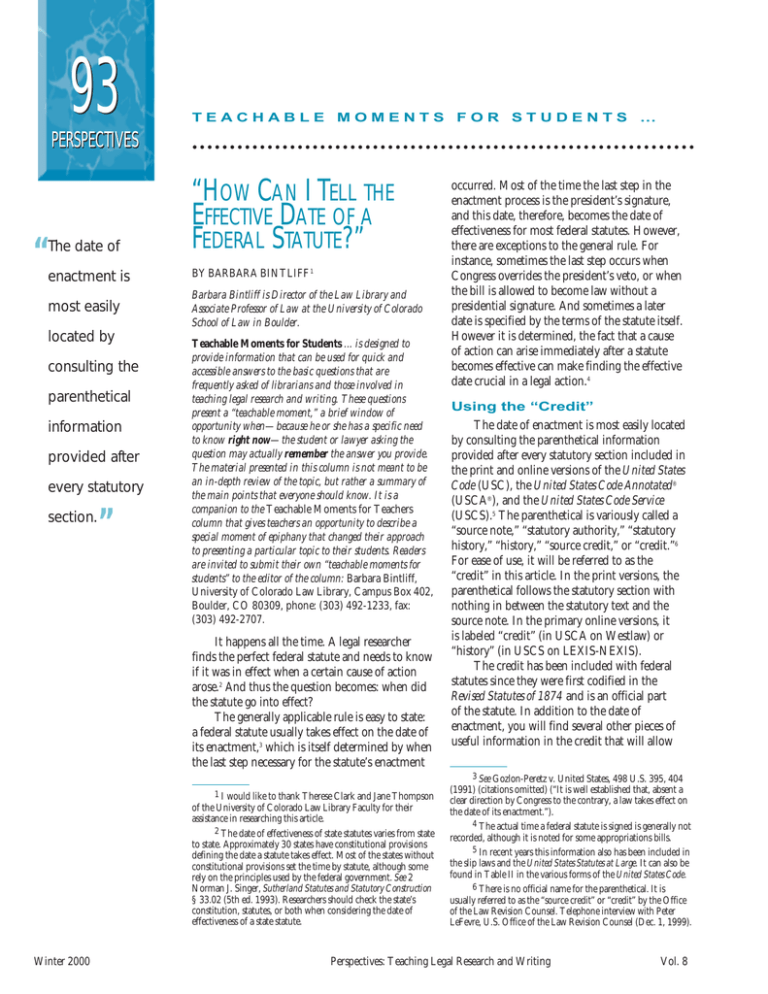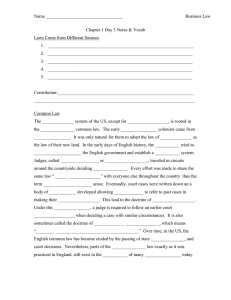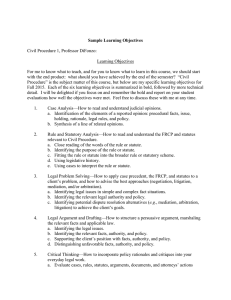how can i tell the effective date of a federal statute?
advertisement

93 TEACHABLE MOMENTS FOR STUDENTS … PERSPECTIVES “The date of “HOW CAN I TELL THE EFFECTIVE DATE OF A FEDERAL STATUTE?” enactment is BY BARBARA BINTLIFF 1 most easily Barbara Bintliff is Director of the Law Library and Associate Professor of Law at the University of Colorado School of Law in Boulder. located by consulting the parenthetical information provided after every statutory ” section. Teachable Moments for Students ... is designed to provide information that can be used for quick and accessible answers to the basic questions that are frequently asked of librarians and those involved in teaching legal research and writing. These questions present a “teachable moment,” a brief window of opportunity when—because he or she has a specific need to know right now—the student or lawyer asking the question may actually remember the answer you provide. The material presented in this column is not meant to be an in-depth review of the topic, but rather a summary of the main points that everyone should know. It is a companion to the Teachable Moments for Teachers column that gives teachers an opportunity to describe a special moment of epiphany that changed their approach to presenting a particular topic to their students. Readers are invited to submit their own “teachable moments for students” to the editor of the column: Barbara Bintliff, University of Colorado Law Library, Campus Box 402, Boulder, CO 80309, phone: (303) 492-1233, fax: (303) 492-2707. It happens all the time. A legal researcher finds the perfect federal statute and needs to know if it was in effect when a certain cause of action arose.2 And thus the question becomes: when did the statute go into effect? The generally applicable rule is easy to state: a federal statute usually takes effect on the date of its enactment,3 which is itself determined by when the last step necessary for the statute’s enactment 1 I would like to thank Therese Clark and Jane Thompson of the University of Colorado Law Library Faculty for their assistance in researching this article. 2 The date of effectiveness of state statutes varies from state to state. Approximately 30 states have constitutional provisions defining the date a statute takes effect. Most of the states without constitutional provisions set the time by statute, although some rely on the principles used by the federal government. See 2 Norman J. Singer, Sutherland Statutes and Statutory Construction § 33.02 (5th ed. 1993). Researchers should check the state’s constitution, statutes, or both when considering the date of effectiveness of a state statute. Winter 2000 occurred. Most of the time the last step in the enactment process is the president’s signature, and this date, therefore, becomes the date of effectiveness for most federal statutes. However, there are exceptions to the general rule. For instance, sometimes the last step occurs when Congress overrides the president’s veto, or when the bill is allowed to become law without a presidential signature. And sometimes a later date is specified by the terms of the statute itself. However it is determined, the fact that a cause of action can arise immediately after a statute becomes effective can make finding the effective date crucial in a legal action.4 Using the “Credit” The date of enactment is most easily located by consulting the parenthetical information provided after every statutory section included in the print and online versions of the United States Code (USC), the United States Code Annotated® (USCA®), and the United States Code Service (USCS).5 The parenthetical is variously called a “source note,” “statutory authority,” “statutory history,” “history,” “source credit,” or “credit.”6 For ease of use, it will be referred to as the “credit” in this article. In the print versions, the parenthetical follows the statutory section with nothing in between the statutory text and the source note. In the primary online versions, it is labeled “credit” (in USCA on Westlaw) or “history” (in USCS on LEXIS-NEXIS). The credit has been included with federal statutes since they were first codified in the Revised Statutes of 1874 and is an official part of the statute. In addition to the date of enactment, you will find several other pieces of useful information in the credit that will allow 3 See Gozlon-Peretz v. United States, 498 U.S. 395, 404 (1991) (citations omitted) (“It is well established that, absent a clear direction by Congress to the contrary, a law takes effect on the date of its enactment.”). 4 The actual time a federal statute is signed is generally not recorded, although it is noted for some appropriations bills. 5 In recent years this information also has been included in the slip laws and the United States Statutes at Large. It can also be found in Table II in the various forms of the United States Code. 6 There is no official name for the parenthetical. It is usually referred to as the “source credit” or “credit” by the Office of the Law Revision Counsel. Telephone interview with Peter LeFevre, U.S. Office of the Law Revision Counsel (Dec. 1, 1999). Perspectives: Teaching Legal Research and Writing Vol. 8 94 PERSPECTIVES you to see the statutory section in its context as originally written, to compile a legislative history, and to track amendments to the statutory text. As an example, let’s look at the credit for 7 U.S.C. § 6104. This is the section of the “Mushroom Promotion, Research, and Consumer Information Act of 1990” that, among other things, establishes the Mushroom Council.7 The credit reads: (Pub.L. 101-624, Title XIX, § 1925, Nov. 28, 1990, 104 Stat. 3857; Pub.L. 102-237, Title VIII, § 803(1), Dec. 13, 1991, 105 Stat. 1882.) Two dates in this credit are relevant to our quest for the effective date of the statute: November 28, 1990, and December 13, 1991. These are the dates that the bills creating the statute and later amending it, respectively, were signed by the president. These are the statute’s and amendment’s enactment dates, and therefore their dates of effectiveness, unless otherwise noted.8 Effectiveness Other Than Enactment Date There are several places to look for the date of effectiveness for a statute that did not become effective upon enactment, or for a statute for which portions take effect at different times. The primary versions of the federal statutes generally have clear notices of any variation on the date of effectiveness. In the USCA, this information may be in an italicized paragraph following the credit or it may be included in the “historical and statutory notes” or the “amendment history” section. In the USCS, it may appear as a boldface 7 While some may question the importance of the Mushroom Council to our federal government, millions of pizza lovers and vegetarians would rise to its defense. 8 The other information in the credit gives the public law citation (that is, the slip law citation) for the statute, pinpointing the exact section in the public law where the language you have can be located. In this case, 7 U.S.C. § 6104 was created by § 1925 of Pub. L. No. 101–624. Title XIX refers to the internal organization of Pub. L. No. 101–624; it was divided into at least 19 titles, or subchapters. Similarly, the statute was amended by § 803(1), of Title VIII, of Pub. L. No. 102–237. Knowing this, the legal researcher can locate the enacted form of the legislation, read the statutory section in its original context, and locate related sections, regardless of where they were eventually codified. The public law citation is also a starting point for legislative history research. The source note also gives the United States Statutes at Large citation for the statutory section. In many instances, the Statutes at Large will be the positive law source for a federal statute. Vol. 8 “caution” following the statutory section’s caption or in the “history; ancillary laws and directives” section. The USC includes the information in a section labeled “amendments.” Editorial policy may dictate a change in labeling or the exact location of the information, but it will be included with the text of the statutes. An example of this is the “Homeowners Protection Act of 1998.” Enacted as Pub. L. No. 105–216 on July 29, 1998, sections 2 through 11 were codified in 12 U.S.C.A. §§ 4901–4910. Section 13 of Pub. L. No. 105–216, captioned “Effective Date,” states, “This Act, other than section 14, shall become effective one year after the date of enactment of this Act.” The USC, USCA, and USCS clearly note this at each codified section, and USCA also includes a note at 12 U.S.C.A. ch. 49. Section 14 of Pub. L. No. 105–216 abolishes the Thrift Depositor Protection Oversight Board of the Federal Home Loan Bank and transfers the duties of the Board to the Secretary of the Treasury, effective three months after the date of enactment of the statute. The Board’s demise, and the effective date of the transfer of its duties, is duly recorded in the various versions of the United States Code in the notes following the statutory section. Another place to check for the date of effectiveness of a federal statute is in its slip or session law publication forms. If the statute as enacted specified a date of effectiveness, the slip law—available in print and online versions from the Government Printing Office and in the U.S.Code Congressional & Administrative News® and U.S.C.S. Advance—and the online and print versions of the United States Statutes at Large will include the appropriate statutory section. “There are several places to look for the date of effectiveness for a statute that did not become effective upon enactment, or for a statute for which portions take effect at different ” times. Conclusion Statutory research isn’t complete without checking the date of effectiveness of the statutory sections you have identified. You should keep in mind the general rule that a statute becomes effective upon enactment, and be alert for possible exceptions. © 2000 Barbara Bintliff Perspectives: Teaching Legal Research and Writing Winter 2000

